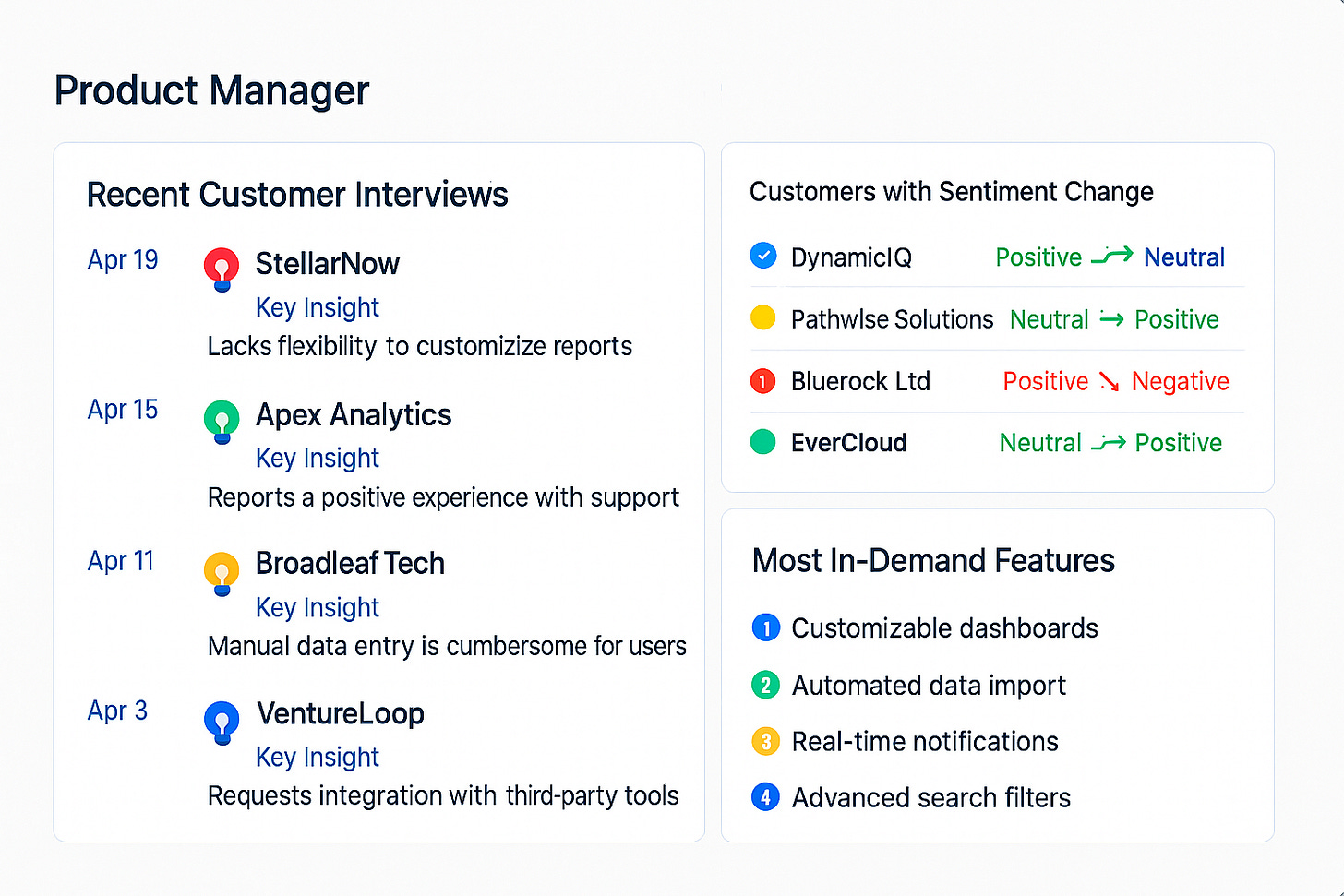What Six PM's Built on a Friday Afternoon
Last week, a half dozen Product people assembled in the hopes of solving a gaping product ops problem. I was shocked at the results.
“Water, water everywhere but not a drop to drink,” said the man in the rowboat lost at sea. I’m lost at sea too. The sea of AI, apps, data and automation. It all exists and threatening our jobs (I think) but I can’t seem to find a solution to truly help me understand my customer.
So, as part of ProductCamp Boston, I signed up for a workshop session and asked for volunteers to come help design a “CRM for Product People”. (It was a terrible, hookless title I admit, but selected nonetheless.) When I arrived at our assigned room, it was empty. And it remained empty until two PM’s in the investments industry joined me. Then, a pricing expert. Then, a PM for an actual CRM company! Lastly, an experienced PM who’s dabbled on the Product Marketing side too. We had a small but mighty team.
Lo and behold, I wasn’t the only one who struggled with this singular problem: “How do I easily assemble an insightful, concise 360 degree view of my customer?” I have been tasked with this in my last two client engagements and failed to find a good tech solution in each case.
It seems the data that we need remains scattered across various repositories. Sure, the CRM system has a bunch of fields and values, but it’s often too crowded to glean real insights. And I record all my customer calls but the recordings, transcripts, AI synapses sort of get dumped somewhere. Same with usage data. So, we asked, how do we collect this information and make the most of it? I had ideas going into the session but what my new Product friends brought to the table blew my ideas out of the water. I was shocked at both the consistency in our frustrations but also the diversity in ideas we garnered to fix this problem.
Ultimately, our ninety minute brainstorming session resulted in the following notes:
🧩Core Problems Identified
Data fragmentation: Information is spread across different databases.
Stagnant or untracked clients: Hard to track client engagement over time.
Prioritized clients are difficult to monitor.
CRM data gaps: Blank or incomplete information makes CRM data untrustworthy.
Cost sensitivity: Price of current solutions is an issue.
Low volume of customer insights collected.
🔐 Risks / Challenges
Privacy concerns
Sensitive data handling
Adoption challenges (especially in capturing in-person interactions)
Capturing offline or informal conversations
💡 Solution Concepts
No manual data entry
Use of AI (e.g., Gemini) to assist with:
Auto-generating a heat map of customers
Detecting patterns across attributes
Maintaining a news feed summarizing updates and notes
Breaking down silos so data is shareable and actionable
Identifying trends around needs
Enriching each interaction with:
Intelligence
Headlines
Scoring
Generate prompts with questions, personalized at:
The individual level
Aggregated across accounts
🎯 What to Capture
Qualitative:
Customer pain points
AI-analyzed call data
Quantitative:
Versioning and product usage
Firmographics
Scoring based on:
Fit
WTP (Willingness to Pay)
Engagement data
Open details and interaction sentiment
I’ve read through this list several times now, asking the all-important Product Manager question: “Where do we start?” If I were to build this, I’d start with something simple. I’d take the calls we’ve recorded, synthesize for insights, risks, feature requests, sentiment and then blend that with some basic CRM data. Maybe, as a stretch, I’d pull in some usage data too. The secret sauce, I imagine, would be marrying the data. Then again, isn’t that what artificial intelligence is supposed to afford us? Next, I’d build out a dashboard based on what our brainstorming team laid out. This solution would provide a rolling newsfeed for customer updates, a ranking top feature requests and a scoreboard for customer sentiment. Of course, there’s a lot more detail, but even this jumping off point would be a massive upgrade from what I’m doing now (which is coursing through this data manually). Best of all? It would require very little manual effort. Here’s an AI-generated image of the dashboard:
There’s likely a million companies that have built something like this, right? Maybe? I want simple. I want insightful. Most of all, I’d something purpose-built for the Product Manager. Am I alone?
Please share your thoughts in the comments, and let’s keep the brainstorming going. What do we need as PM’s? What do you use today to solve this problem? Is it enough?


